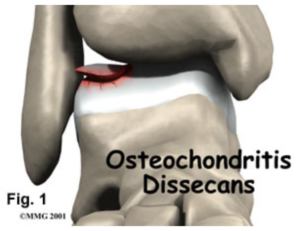COMMON CONDITIONS
Osteochondritis Dissecans | What is Osteochondritis? | Osteochondritis Symptoms, Causes and Treatment IN RICHARDSON, DALLAS, GARLAND, WYLIE, MURPHY.
What is Osteochondritis Dissecans?
“Osteo” means bone and “chondral” refers to cartilage. The ankle joint is composed of the bottom of the tibia (shin) bone and the top of the talus (ankle) bone. The top of the talus is dome-shaped and is completely covered with cartilage—a tough, rubbery tissue that enables the ankle to move smoothly. A talar dome lesion is an injury to the cartilage and underlying bone of the talus within the ankle joint. It is also called an osteochondral defect (OCD) or osteochondral lesion of the talus (OLT) or Osteochondritis Dissecans.

Talar dome lesions are usually caused by an injury, such as an ankle sprain. If the cartilage does not heal properly following the injury, it softens and begins to break off. Sometimes a broken piece of the damaged cartilage and bone will float in the ankle. Osteochondritis dissecans is can be found in children and adolescent due to the extensive working and playing. It is often seen in adults following an ankle injury.
It is pertinent to know the causes of the disorder in order to understand and address it properly. Some of the common causes have been listed bellow
Causes of Osteochondritis Dissecans:
- High impact activity with more frequency. Jumping and running may cause the disorder.
- Blood flow hindrance is also one of the causes
- The disorder might have a hereditary correlation
Here are some of the symptoms of Osteochondritis.
Symptoms of Osteochondritis:
The signs and symptoms of a talar dome lesion may include:
- Chronic pain deep in the ankle—typically worse when bearing weight on the foot (especially during sports) and less when resting.
- An occasional clicking or catching feeling in the ankle when walking.
- A sensation of the ankle locking or giving out due to locking of the loose parts.
- Episodes of swelling of the ankle—occurring when bearing weight and subsiding when at rest.
- Decreased movement of the joint and incase of movement pain strikes may happen.
Timely treatment of the Osteochondritis is very important to avoid long term effects of the disorder. You must consult with a physician right away if you suspect that you have this condition.
Treatment of Osteochondritis:
People often ask about the curability of the Osteochondritis disorder – Osteochondritis. The disorder is curable. Treatment depends on the severity of the talar dome lesion. If the lesion is stable (without loose pieces of cartilage or bone), one or more of the following nonsurgical treatment options may be considered:
- Immobilization: Depending on the type of injury, the leg may be placed in a cast or cast boot to protect the talus. During this period of immobilization, non-weight bearing range-of-motion exercises may be recommended.
- Oral medications: Non-steroidal anti-inflammatory drugs (NSAIDs), such as ibuprofen, may be helpful in reducing the pain and inflammation.
- Physical therapy: Range-of-motion and strengthening exercises are beneficial once the lesion is adequately healed. Physical therapy may also include techniques to reduce pain and swelling.
- Ankle brace: Wearing an ankle brace may help protect the patient from re-injury if the ankle is unstable.
When Is Surgery Needed?
If nonsurgical treatment fails to relieve the symptoms of talar dome lesions, surgery may be necessary. Surgery may involve removal of the loose bone and cartilage fragments within the joint and establishing an environment for healing. A variety of surgical techniques is available to accomplish this.
How long is recuperation after surgery for Osteochondritis dissecans?
After surgery, a patient needs to be at rest and immobilized for some time. The physiotherapy starts after 2 to 4 weeks. Afterwards, the patient needs to be on the crutches for 4 to 6 weeks.
Can Osteochondritis come back?
Usually the healing of the Osteochondritis dissecans takes place up to 3 months.
Consult your physician to avoid long term damage.
Osteochondritis Dissecans | What is Osteochondritis? | Osteochondritis Symptoms, Causes and Treatment IN RICHARDSON, DALLAS, GARLAND, WYLIE, MURPHY.
Dr. Raymond Delpak works with patients to determine the best course of action for treating foot and ankle problems. We use the most advanced techniques possible. If you would like to learn more, please visit us TX Foot and Ankle Consultants or schedule an appointment.
SUBSCRIBE TO OUR NEWSLETTER
*for updates on our medical equipment only

